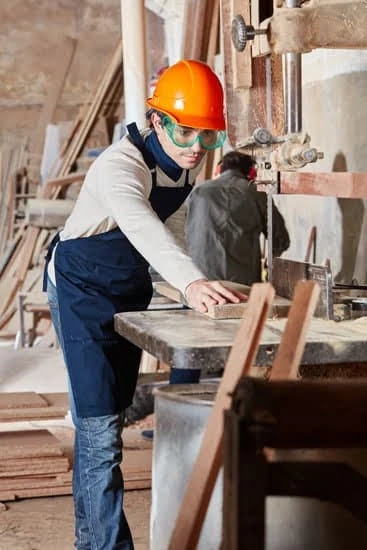Introduction What Is a Drill Press and How Does It Work?
A drill press is a tool used in woodworking to drive specially designed drill bits into material to produce precise holes and pockets. The motion of the drill bit is guided by the drill press, which makes it a very precise and powerful tool for making accurate and repeatable holes in any type of material. The operator sets the desired size and location of the hole before drilling.
The most common use of a drill press in woodworking is to make mortise and tenon joinery or to cut dovetail joints with precision. In either case, once the desired spot has been marked out on the material, a chisel style bit or jig is employed to create perfectly formed slots that can then be fitted together to form joinery or intricate dowels. Other uses may include drilling dowel or plug holes for furniture projects, creating strategically placed threaded inserts or through-holes for drawers and other cabinetry projects, as well as general wood fastening such as screws, nails, and bolts. Not only does it provide an opportunity for fine tuning particularly difficult elements in woodworking but also offers quick set-up times so one screw can be fixed without having to take apart multiple pieces every time a new screw needs tightening. Additionally, certain specialized drills are available specifically for use with hardwoods such as oak and walnut so these projects can be completed with greater ease than if using hand tools on stubborn woods.
Benefits of Using a Drill Press for Woodworking
A drill press is an invaluable tool for woodworking projects. It provides greater accuracy than a hand held drill and can provide perfect holes every time. With a drill press, the exact location of your hole can be determined before drilling, minimizing mistakes and waste of materials. As a result, woodworkers get more predictable results with cleaner, deeper holes than with a handheld drill.
Using a drill press also allows for more precise drilling at different angles and depths, allowing you to make mortise and tenon joints or angled pockets with ease. Drill presses are also great for creating square holes that are much harder to do with a handheld drill. The right chuck size will also allow for variety in the bits you use”for example, larger drills and router bits.
Another great advantage of using a drill press is the speed set regulation option which allows users to adjust their desired speed without the need to stop or change pulleys or belts in order to reach desired speeds (which can happen inadvertently with other types of drills). This feature helps prevent wasting time adjusting gears between batches of work. In addition, most drill presses include variable speeds, allowing greater control over drilling into various surfaces from softwood to hardwood and metals.
Finally, accessories such as sanders can be attached to some stationary presses providing even more capability and taking away the hassle of transferring tools between machines. This saves both time and energy while streamlining operations when completing complex projects.
Different Types of Drill Presses Used in Woodworking
The drill press is a popular tool used in woodworking and it has been refined over the years to meet the needs of many types of tasks. In general, there are four main types of drill presses: bench-top drill presses, floor-standing drill presses, specialty models such as spindle sanders, and handheld electric drills. Each type has its own advantages and uses in woodworking.
Bench-top drill presses usually range from 3/4″ to 1 1/2″ in size, making them perfect for basic drilling into various materials. They are lightweight and easy to use with most common bits. Floor standing models are more robust and allow more accurate drilling up to 4″ or more. These come with accessories like a fence, miter gauge, or table extensions according to user’s individual needs. Specialty models include those specifically designed for sanding or routing material accurately and quickly while hand electric drills are ideal for light work around the workshop whenever precision isn’t essential.
In addition to the usual uses such as drilling holes into wood, metal or plastic materials, a drill press can also be used in conjunction with sanders or routers to shape specific parts with precision. For example, when cutting out wooden chess pieces you could use a router mounted onto the bed of a larger floor standing model for accuracy. Or you could use an attachment designed to clamp the material onto the bed of your bench-top drill press so that you can properly shape each piece by hand due to its smaller dimensions or delicate form. Whatever type of work you need it can accomplish it accurately with one of these machine types.
Basic Safety Procedures For Operating A Drill Press
Drill presses can be used in a variety of woodworking projects. Drilling holes for furniture joinery, making mortise and tenon joints, boring out large dowels and creating dowel joinery are all tasks that a drill press can do efficiently while achieving the desired results with accuracy.
Basic safety procedures for operating a drill press include:
# Ensure that the workpiece is properly secured to the table before drilling.
# Wear appropriate eye protection when operating the drill press.
# Exercise caution when positioning your hands near spinning bits and blades.
# Check to make sure that all of the necessary adjustments have been made before powering on the machine.
# Always use sharp cutting tools and check them regularly for wear or damage.
# Make sure to turn off the machine and unplug it from the power source when changing bits or making adjustments.
# Unplugging from power source and waiting until all parts have stopped spinning before reaching into the guard housing for any type of adjustment or cleaning.
Common Applications of Drill Presses in Woodworking Projects
Drill presses are an invaluable tool for woodworkers. Its precision and power makes it a great option for drilling accurate, clean holes in wood. With the right size bit and accessories, they can also be used to countersink screws, enlarge existing holes, sand and shape small pieces, bore out recessed door handles, mortise hinges easily, and so much more. It’s also extremely useful when needing to make perfectly angled or angled holes, such as pocket hole jointing.
Another common application of drill presses for woodworking projects is creating curved shapes on pieces of wood. By using various specialty bits like veining cutters or groove cutters that have a rounded profile, you can “draw” curved lines with ease onto any piece of wood ranging from thick plywood all the way down to small trim pieces. The adjustable depth settings allow you to go deeper into the wood with each pass going over your design until the desired depth is achieved without having to remove the workpiece from the machine.
The added capabilities of adjustable speeds settings give you even more control when working with drill press in your shop. Use slower RPMs to work with thinner materials like cabinet grade hardwoods or plywood without compromising accuracy, then boost up speeds settings when needed for drilling holes or cutting through thicker stock quickly and safely. Last but not least, advanced models come equipped with digital displays that let you precisely set RPMs, speeds & depths settings all at once making even complex pattern creation becomes easier than ever!
Drill Press Attachments Used in Woodworking
A drill press is a versatile tool for woodworking, allowing for accurate measurements and precise drilling operations. Using a drill press also eliminates the need to manually operate the power drills, enabling users to work more accurately and faster. With its adjustable motor speeds, the drill press offers excellent control over the speed at which material is drilled into.
Some of the most common drill press attachments used in woodworking are; Forstener bits for drilling flat-bottomed holes; spade bits for quickly and cleanly drilling large holes in softwood; hole saws that make clean round holes with smooth edges; and precision sanding drums to sand curved surfaces with ease. Other popular attachments include depth stop collars and boring bars that help maintain accuracy when drilling shallow or deep to specific depths. An adjustable fence adds rigidity when drilling multiple pieces and straightness when working on an angled surface. With additional attachments such as mortising chisels, end milling cutters, taper reamers, rotary files, self-centering drill guides and others woodworkers have complete range of options while working on different projects.
Factors to Consider When Buying a Drill Press for Woodworking
Drill presses are invaluable tools for woodworkers, allowing for precision and accuracy when drilling into a variety of materials. They can be used for a wide range of tasks such as drilling holes, countersinking, counterboring, reaming, mortising and much more. When shopping for a drill press to use in woodworking projects, there are several factors you should consider:
1. Horsepower ” The higher the horsepower rating on a drill press, the better it will perform with tougher materials. Check the reviews of each option to determine which machines will handle your material of choice without difficulty.
2. Table Size ” The table size should accommodate your project materials effectively and ensure stability during operation. Having enough space to securely hold larger objects will result in more accurate results and increased safety while using the drill press. Choose carefully based on what works best for your projects.
3. Speed Settings ” For maximum control over your project materials, look for a machine that offers adjustable speed settings so you can adjust these whenever needed to suit different workpieces or other needs that may arise. This also allows you to make gradual changes as needed instead of having to manually adjust every setting between uses.
4. Chuck Size ” Drilling holes that differ in size also differs in bit capacity; therefore consider the chuck size when selecting a drill press so you know it is compatible with your current bits and future projects requiring different ones that may require larger capacity chucks.
5. Price ” Of course one of the most important factors when buying any tool is budget! Make sure you measure all aspects thoroughly before investing in something expensive that could prevent you from completing future projects adequately or safely due to its limitations or lack of features/capabilities compared to its price range competitors . Remember this tool is an investment that should last a long time if treated properly and maintained regularly so don’t forget quality over quantity – something cheaper does not always mean better!
Different Options for Powering a Drill Press
The drill press is commonly used for a variety of woodworking projects, from creating precise holes for joining to routing decorative components in joinery. Some models have integrated power tools such as hole saws and router bits that can be attached to the spindle, making them extremely versatile tools. Drill presses can be powered by electricity (with an electric motor) or pneumatically driven with compressed air. With both options, you can adjust rotational speed and torque allowing more precise control when cutting hard materials like steel or large diameter holes through softer woods. Power settings also limit vibration while working on more delicate workpieces, allowing you to make clean cuts without concern of burning the surface of your material.
Conclusion Why A Drill Press Is Essential for Woodworking Projects
A drill press is essential for any woodworking projects that involve precise drilling and accuracy. It allows you to be consistent with the depth and angle you desire each time. With its wide range of speeds, it can be used for most materials from hardwoods to soft plastics and make clean holes with minimal tearout. Furthermore, a drill press provides horizontal support when boring large holes into thick boards removing the risk of bit deflection or burning. This additional precision can be especially useful for making mortises on joints and dowel holes. An even more precise way to make mortises is by using a jig like a DJ20 holemaker which attaches directly to your drill press allowing you to easily line up perfect paralles holes in repetitive manner. Finally, a drill press also allows you to use larger bits than what is typically available in hand-held models so it’s great for larger projects such as shelves or cabinetry work. By having control over the spindle speed, feed rate, and the ability to use various sizes bits, a drill press helps ensure repetitive accuracy in your project results everytime making it an invaluable tool for almost any woodworking endeavor.

Hi everyone! I’m a woodworker and blogger, and this is my woodworking blog. In my blog, I share tips and tricks for woodworkers of all skill levels, as well as project ideas that you can try yourself.





